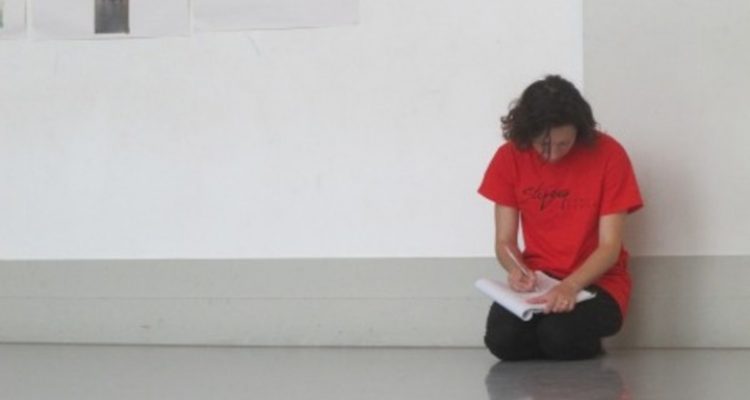In this first blog about Stopgap’s next major production The Enormous Room, Artistic Director Lucy Bennett talks about the overall concept and how ideas for the work developed and changed.

Lucy, with her back to the camera, looking at a set model of The Enormous Room and four dancers draped around the set pieces and furniture.
I spend so long thinking about an idea and letting it form before even beginning to communicate it to others, that it is often hard to locate its origins. However ‘The Enormous Room’ is a little different – I can pinpoint exactly when, where and how the first image popped into my head.
I was lucky enough to listen to Hofesh Shechter talking with William Forsythe as part of The Brighton Festival in 2014. As a young choreographer Forsythe had had some invaluable advice from his ballet teacher. When struggling to make a work his teacher had said; ‘Close your eyes, imagine the piece that you want to watch and make that one’.
At that moment I did just that. I saw a small room full of clutter and dark furniture set within a big space. I saw characters appearing and disappearing through drawers and cupboards, the dancers were restricted and their limbs and faces told the story.
From there the journey is a massive meander for two years I let ideas float in and out, cast my dancers in different roles and explored forms and narratives without stepping in a studio. The following ideas emerged:
I became certain I wanted Dave Toole to be my central character.
I was interested in text and Dave and I had spoken about exploring this as well as creating a rich dance theatre character for him to get his teeth into.
I had an image of the dancers being trapped for one scene, then released in the following scene. I also had a strong image of a wide-open space and Nadenh Poan freewheeling whilst moving within his wheelchair in a portrayal of freedom.
I think this came from a conversation from an audience member who had seen ‘Artificial Things’. She explained she craved for wheelchair dancer Laura Jones to be released from her chair, yet when Laura did dance out of her chair – she felt she wanted her to get back in. I became intrigued with sharing the freedom of gliding in a chair as well as the concept of being both in and out of the chair simultaneously.
In fact quite early on in my ideas Chris Pavia dressed in a tuxedo began appearing in the cupboards every time Dave opened them. It seemed to me that Chris was playing ‘Death’ but as a forever friendly face ready to meet Dave on his next journey and yet Dave was too busy to die – he had unfinished business.
Chris has spent his whole career hiding from me and trying to surprise me (which he does). I have always thought this might be the last thing I experience – frightened to death by a ‘boo’ from Chris.
Once we got in the studio things of course changed! The team offered new avenues to explore. New relationships developed alongside new inclusive choreographic ideas.
Chris Pavia who has been in nearly every production of Stopgaps since 1997 made the difficult decision to not be in the main touring production in order to focus on his choreography. Laura Jones too decided she want to concentrate on advocacy for disabled dancers and felt that touring would make that difficult. Both Chris and Laura continued to contribute to my ideas in the R&D leading up to creation and as we are the masters of translation Chris’ and Laura’s experience proved very useful to the other members of the cast.
One day in a company improvisation jam I noticed that a precious and subtle relationship was developing between Dave Toole and at the time Sg2 dancer Hannah Sampson. For the first time I saw a casting that wasn’t two lovers but that of a father and daughter dancing together. This was a real shift and something that I felt was strong and new – something I had been looking for.
This became our starting point.

